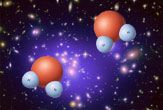Old Star's Super-Hot Water Vapor Surprises Scientists

Scalding hot water vapor has been discovered in the atmosphere of an aging star, surprising scientists who thought the chemistry of such stars would forbid it
Water exists as a gas at a scorching 1,300 degrees Fahrenheit (700 degrees Celsius) in the outer atmosphere of the star called IRC+100216, 500 light-years from Earth. Scientists first detected hints of water vapor in the star in 2001, but a new study has confirmed the water's super-hot temperature and debunked a proposed explanation for its presence, creating an even bigger head-scratcher for scientists.
The chemical signature for water is not a rarity in stars, but in certain elderly stars made mostly of carbon, water was thought to be absent.
Inside a star
As some stars grow old, they become carbon-rich. One of the first molecules to form in these stars is the union of a carbon atom and an oxygen atom: carbon monoxide.
Until now, scientists thought that all the available oxygen in a carbon-rich star like IRC+10216 would be used up in carbon monoxide, leaving none to bond with hydrogen to form water.
Using infrared observations from the European Space Agency's Herschel Space Observatory, a team led by astronomer Leen Decin of Katholieke Universiteit Leuven in Belgium found that water is definitely present at extremely hot temperatures.
Sign up for the Live Science daily newsletter now
Get the world’s most fascinating discoveries delivered straight to your inbox.
Such sizzling temperatures also seem to counter one of the most popular explanations for the presence of water in the star — that it had vaporized off icy comets that passed too near the star and were swallowed, researchers said.
The recorded temperatures suggest instead that the water lies in the heated outer envelope layer of the star.
The findings are detailed in the Sept. 2 issue of the journal Nature.
Tricky star chemistry
To explain the observations, researchers had to consider more-complicated processes inside what was once considered a fairly smooth, homogeneous layer of the star.
The star's outer atmosphere envelope may actually be clumpy in some spots and thinner in others, researchers said. This would allow photons of ultraviolet light from interstellar space to punch through and strip oxygen atoms from carbon monoxide molecules, freeing the atoms to join up with hydrogen.
"It shows us our ideas about chemistry are too much simplified and there are a lot of other processes induced by these UV photons which we have to consider," Decin told SPACE.com.
In fact, taking into account the possible effects from interloper photons could change astronomers' understanding of what goes on inside many different stars, not just these aged carbon-rich types, she added.
"When we do new simulations we indeed see completely new chemistry that takes place," Decin said.










